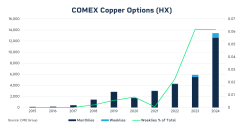Scott Bauer, for CME Group
At a Glance:
- Online dating traffic, cardboard box production and movie success offer insights into consumer behavior and economic health.
- The combined occurrence of informal indicators can highlight broader economic issues.
Plenty of economic indicators utilize a variety of data to provide some explanation for where the market could be heading and some may be more useful than others. But what about some lesser known “obscure” indicators? From men’s underwear to lipstick; from Big Mac’s to hemlines; from sausage sales to the tooth fairy, there are other ways to gain insights into economic health. Peter C. Earle, a senior economist at the American Institute for Economic Research, highlights that while informal indicators may not be conclusive on their own, their combined occurrence can point to broader economic issues.
There are a few of these lesser-known indicators I believe give keen insight into the state of the economy.
The First Date Indicator
There is a significant increase in traffic on online dating sites, especially during a recession. During prosperous periods, people tend to meet potential partners through in-person activities. However, during downturns, dating apps often see higher engagement as people seek less expensive ways to meet others and support during stressful times. This was studied in the U.S., during the 2008 recession and again after society began opening after the COVID lockdowns when the online dating service Match.com reported that it saw a huge surge in traffic.How About Cardboard Boxes?
The more cardboard boxes being produced, the better the economy typically performs. The demand for cardboard boxes often correlates with economic booms and busts because it strongly represents the level of consumer spending. Given how many items are shipped inside cardboard boxes, it makes sense that demand for cardboard boxes indicates consumer demand for online goods, which could indicate a potential rise or decline in gross domestic product (GDP). As a leading market indicator, it can give investors an early sign of where the economy is headed and investors can take a look at the index for themselves on the Federal Reserve of St. Louis’ website.Market participants can use this information to decide how to manage risk in the manufacturing and retail sectors, the packaging and shipping industries, or even in cyclical stocks that tend to respond more strongly to economic expansions or contractions.
For a similar reason, copper can also be seen as a leading indicator of economic health because of its use across a variety of areas from homes to electric vehicle (EV) production. As demand for copper increases, it typically indicates a growing economy. According to CRU Group research, demand for copper is expected to increase by 12.6 million metric tons by 2040. The need to scale supply to meet future demand has put copper front and center, with COMEX Copper futures and options seeing a record level of participation this year.

The Buttered Popcorn Index
This index suggests that when people are going through financial hardship, they tend to escape to the world of fiction, leading to an increase in the success of the film industry regardless of the quality of films being put out. This index was proven to be accurate when the U.S. box office reported massive success in 2009, a year after the recession had set in. The same happened in 2022, with revenues in the U.S. box office hitting new milestones.While it may seem odd that people are spending more on luxury (i.e. technically unnecessary) goods like popcorn and movies, they are a relatively cheaper luxury when compared to other products like adventure park visits, vacations or concerts. Additionally, when economic distress poses anxiety about general well-being, movies can offer a welcomed and affordable distraction for most people.
At the end of the day, these somewhat unorthodox measures of the economy actually make sense because most of them are consumer discretionary goods. People tend to only spend money on non-essential items or experiences if they have the extra cash or if they are confident they will have the extra cash in the future. While these indicators do offer some insight into the health of an economy, they shouldn’t be relied upon solely to inform investment decisions, as each index has its own biases and limitations.






